
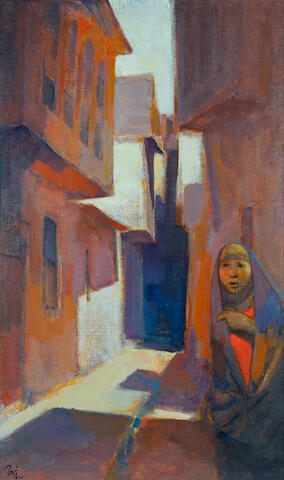
Faeq Hassan was born in Baghdad in 1914 and died in 1992. He graduated from the École des Beaux-Arts, Paris in 1938. He founded the Painting Department at the Fine Arts Institute in 1939-1940. Founded the Pioneers Group (or S.P) in 1950. He participated in its exhibitions until 1967 when he joined in founding the Corner Group and participated in its first exhibition. Took part in the Friends of Art Society in 1943 and 1946. Participated in the Avicenna Exhibition in Baghdad in 1952. Organized a number of one - man exhibitions in Baghdad, in 1962-1967 and 1971. Participated in most national exhibitions outside Iraq. Joined nine artists in the Iraq Art Exhibition in Beirut in 1965. Member of the Iraqi Artists Society. More
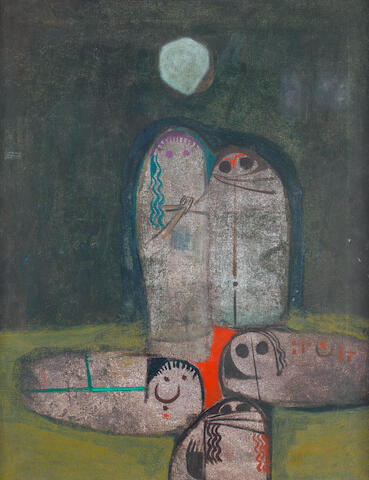
The Marsh Arabs, also known as the Maʻdān (Arabic: معدان), are inhabitants of the Tigris-Euphrates marshlands in the south and east of Iraq and along the Iranian border. Comprising members of many different tribes and tribal confederations that had developed a unique culture centered on the marshes' natural resources. Many of the marshes' inhabitants were displaced when the wetlands were drained during and after the 1991 uprisings in Iraq.
Madan means "dweller in the plains (ʻadan)" and was used disparagingly by desert tribes to refer to those inhabiting the Iraqi river basins. There was a considerable historic prejudice against the Maʻdān, partly as they were considered to have Persian or Indian origin by the sunni Iraqi people, even though there are %100 Arabs, and mostly because of they refused to bow to the sunni dictatorship. More
Born in Baghdad in 1939, Dia Azzawi started his artistic career in 1964, after graduating from the Institute of Fine Arts in Baghdad and completing a degree in archaeology from Baghdad University in 1962.
In 1969, Azzawi (with Rafa Nasiri, Mohammad Muhriddin, Ismail Fattah, Hachem al-Samarchi and Saleh al Jumaie) formed the New Vision group (al-Ru’yya al-Jadidah), uniting fellow artists ideologically and culturally as opposed to stylistically. Through his involvement with the New Vision group Azzawi found inspiration in contemporary subjects and issues, particularly the plight of the Palestinians. He was also briefly a member of Shakir Hassan Al Said’s One Dimension group (Jama’t al-Bu’d al-Wahid).
From 1968 to 1976, Azzawi was the director of the Iraqi Antiquities Department in Baghdad. He has lived in London since 1976, where he served as art advisor to the city’s Iraqi Cultural Centre, from 1977 to 1980. Azzawi’s move to London led him to rediscover book art (dafatir), an art form that he has encouraged other artists from Iraq and the region to explore.
With exhibitions of his work have been held in international, private and public collections including the Museums of Modern Art in Baghdad, Damascus and Tunis; Jordan National Gallery of Fine Arts, Amman; Mathaf: Arab Museum of Modern Art, Doha; Barjeel Art Foundation, Sharjah; Kinda Foundation, Saudi Arabia; Una Foundation, Casablanca; Arab Monetary Fund, Abu Dhabi; Development Fund, Kuwait; Jeddah International Airport; British Museum, Tate Modern, and Victoria and Albert Museum, London; Institut du Monde Arabe, Bibliothèque Nationale de France and Colas Foundation, Paris; Harba Collection, Iraq and Italy; Gulbenkian Collection, Barcelona; and Library of Congress and the World Bank, Washington, DC. More
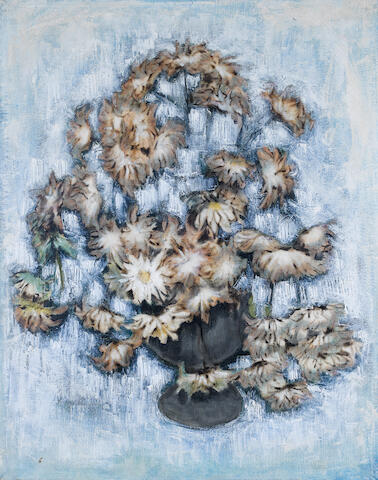
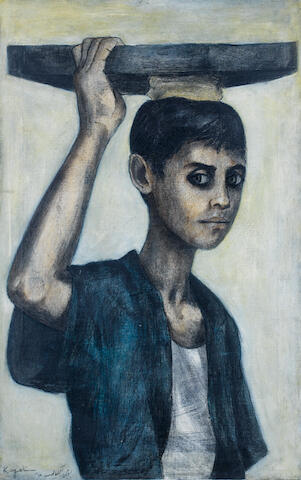
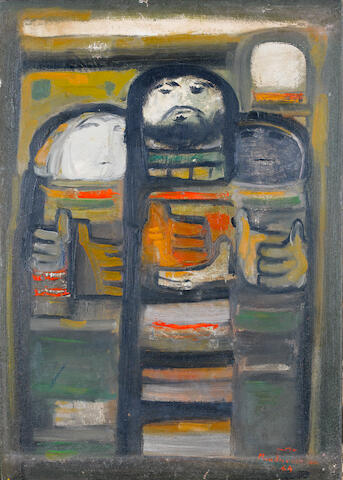
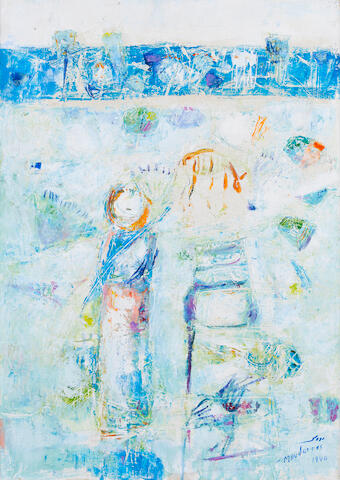
Fateh al-Moudarres (1922–1999) was a Syrian painter . Born in Aleppo, Syria, Fateh Moudarres originally taught himself realist techniques before becoming interested in surrealism. He became one of the leaders of the modern art movement in Syria. Moudarres studied at the Accademia di Belle Arti in Rome. After he completed his studies, he returned to Syria where he grew and honed his skills under the auspices of long-time friend, mentor, and tutor Wahbi Al-Hariri.
Growing up, Fateh Moudarres spent much time in the countryside, but the agricultural crisis of the 1960s forced him to relocate to Damascus. The city at that time was experiencing a period of unprecedented growth and fast becoming an increasingly cramped and hostile environment in which to live. These conditions were compounded by the political and social unrest sweeping the Arab World. Against this backdrop Moudarres, along with several his artist contemporaries, often sought to depict the everyday people and the problems they encountered. He was especially moved by the life of ordinary people in the Syrian countryside. More on Fateh al-Moudarres
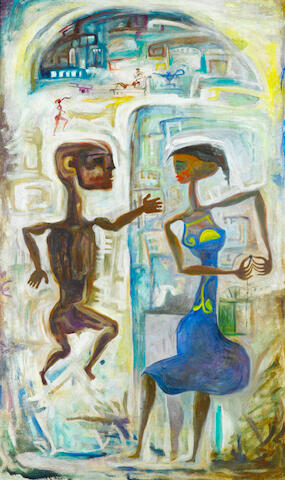
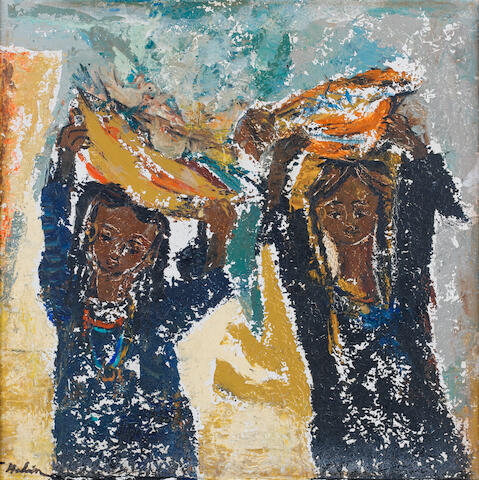
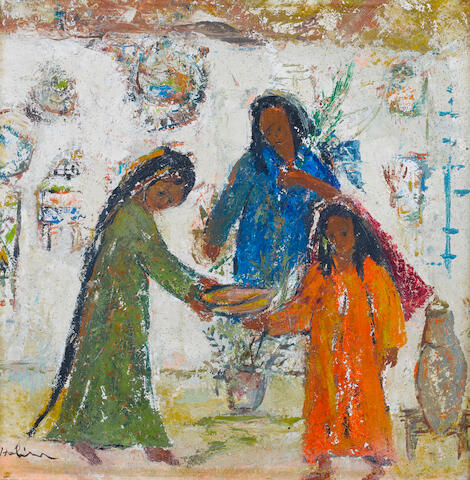
Both trips were to leave lasting impressions on Halim who worked closely with the inhabitants of Nubia to document and study their ways of life, their traditions and rituals. The main reason this trip was organised was to preserve in some way the area around Aswan which was due to be flooded upon completion of the High Dam. More on these paintings
Tahia Mohammed Halim, (Egypt, 1919-2003), was an Egyptian painte, and one of the pioneers of the Modern Expressive Movement in Egyptian Art in the 1960s, where she excelled in expressing the Egyptian character’s idiosyncrasies in her works. She has many works concerning the Nile, boats and the popular and national subjects for which she has been granted several honorary awards in Egypt and abroad.
Tahia Halim was born in Sudan, where her family were living. Her primary education was inside the Royal Palace of Cairo, where she was raised, as her father was the laureate of King Fuad I of Egypt.
Tahia Halim studied art under important drawing teachers as the Lebanese painter Yussef Trabelsi and the Greek artist Gerom; then under the Egyptian artist Hamed Abdullah at his studio 1943, they married in 1945, then left for Paris to join the Julian Academy (1949-1951). After returning to Egypt, they taught art, together, in their private studio, in Down Town (near Tahrir Square) in Cairo. Tahia Halim received two devotion scholarships of Art Production in 1960 and in 1975. More on Tahia Mohammed Halim
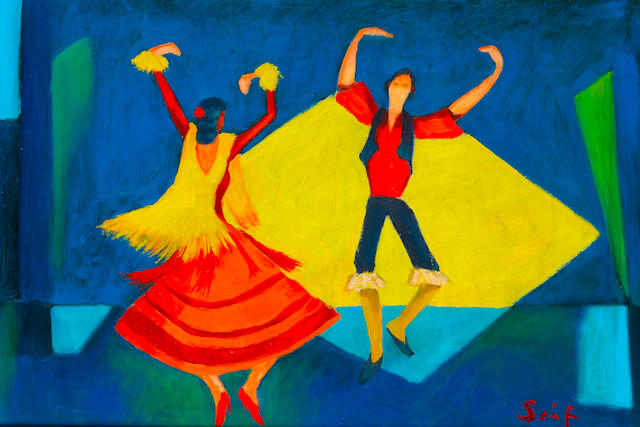
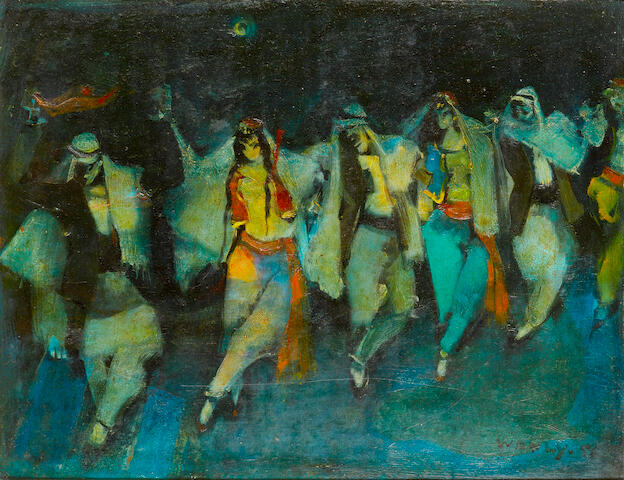
The dabka, literally 'stamping of the feet' is a type of line dance popular at weddings and celebrations throughout the Middle East. In Wanly's work the figures are gracefully depicted, appearing almost to float across the canvas.
Adham Wanly (1908 in Alexandria, Egypt – 1959) was an Egyptian painter who learnt in the atelier of the Italian Otorino Becchi 1932, then set up his own atelier with his brother Seif Wanly (above), and participated in many local and international exhibition specially Venice, São Paulo (Brasil), Alexandria Biennale.
The Museum of Modern Art in Alexandria displays many of his paintings. The artist is mostly famous for recording the life of the theater and circus. He specialized in the ballet and opera as featured in the Cairo Opera House and the Theatre Mohamed Ali, in Alexandria. The paintings render the stage lights and movements of the people involved and he is able to express the light and agility in various ways. He had a talent in caricature in which he used in mockery of himself and the people of his time. There is now a museum in his memory. More


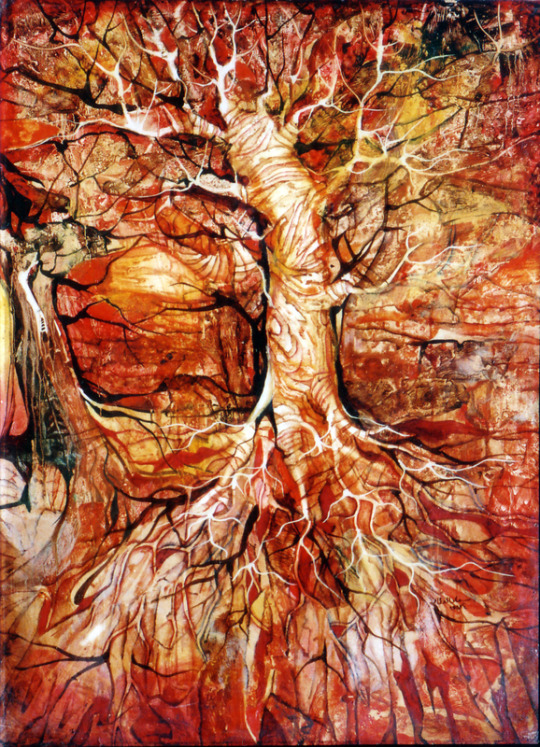
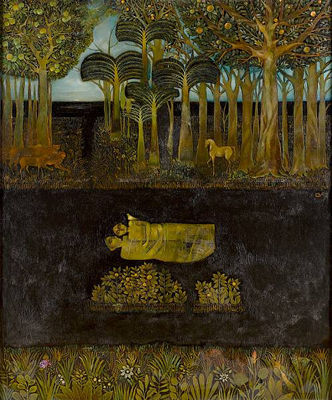
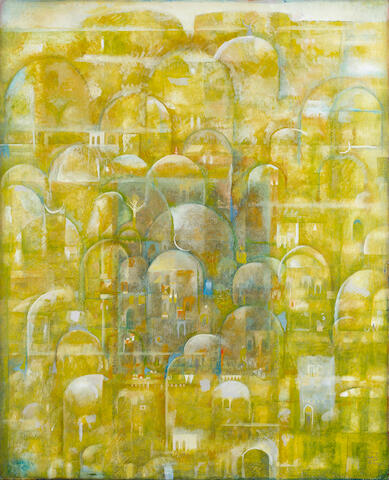
Suad al-Attar (born 1942) is a renowned Iraqi painter whose work is in private and public collections worldwide, including The British Museum and the Gulbenkian Collection. She has held over twenty solo exhibitions, including one in Baghdad that became the first solo exhibition in the country's history for a woman artist. Her many awards include the first prize at the International Biennale in Cairo in 1984 and an award of distinction at the Biennale held in Malta in 1995.
Suad left Baghdad with her husband and children in 1976, and settled in London. For her, the perpetual sense of longing for "home" has always been balanced by an awareness of the freedom that comes with distance. This freedom—a condition that gained added significance following the regime’s rise to power under Saddam Hussein in the late 1970s—has enabled her to explore her relationship with her homeland and to develop a personal visual language with which to express it.
Elements of this language are to be found within the traditions of Middle Eastern art. The winged creatures of Assyrian reliefs, Sumerian sculptures and the illuminated manuscripts of the Baghdadi School were instrumental. However, this awareness of her Arab heritage did not result in slavish imitation, but was forged with her own romantic imagination and an appreciation of western figurative traditions to create enigmatic images in which narrative and symbolism are intertwined.
A substantial monograph documenting her career was published in London in 2004. Much of Suad’s painting is characterised by an intense dreamlike and poetic sensibility that draws on motifs and symbols from within the traditions of Middle Eastern art. In recent years, these richly-coloured representations of paradise and of sleeping cities bathed in turquoise blue, have disappeared from her work as she has become increasingly preoccupied with the plight of Iraq. More on Suad al-Attar
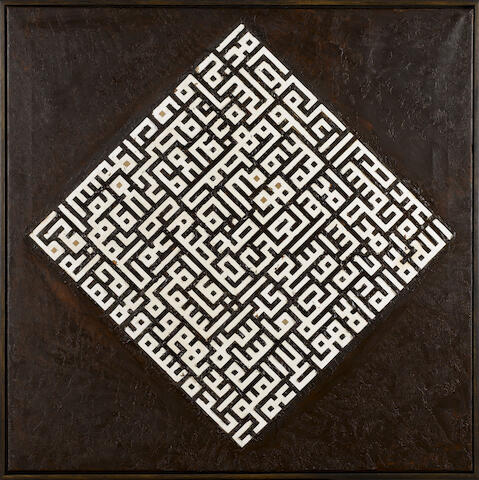
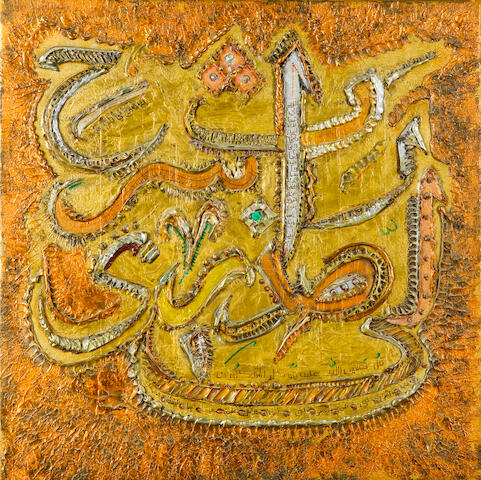
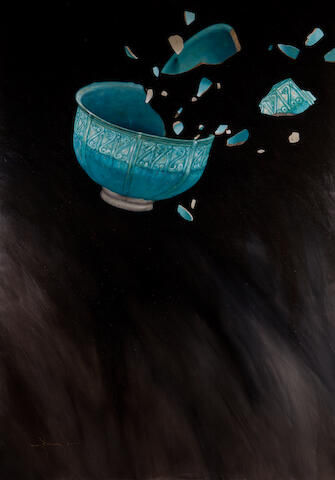
Aydin Aghdashloo (born October 30, 1940; Rasht, Iran) is an Iranian painter, author, art critic, art historian and graphic designer. He currently lives in Tehran, Iran, and lectures in different Iranian Universities besides his professional work.
Early in his career, Aghdashloo took great interest in the Renaissance and Sandro Botticelli's paintings in particular. He even used to test his own skills by copying Botticelli's works to the last detail. His admiration for Renaissance paintings lead to the creation of his "Memories of Destruction" series in the early 1970s which became his most celebrated and famous series. In these series Aghdashloo depicts destruction of identity and beauty by painting a complete Renaissance masterpiece and then partially destroy or deface it.
"Memories of Destruction" continued after 1979 but went through a transformation in which Islamic art became his main model instead of Renaissance art, while in both periods he uses Islamic and Renaissance models simultaneously.
He also uses Persian miniatures extensively in his paintings after 1979. The crumpled Persian miniature series are the best example. More on Aydin Aghdashloo
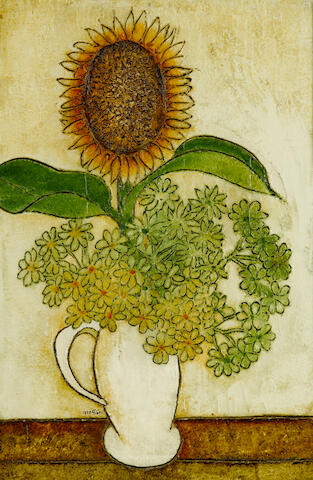

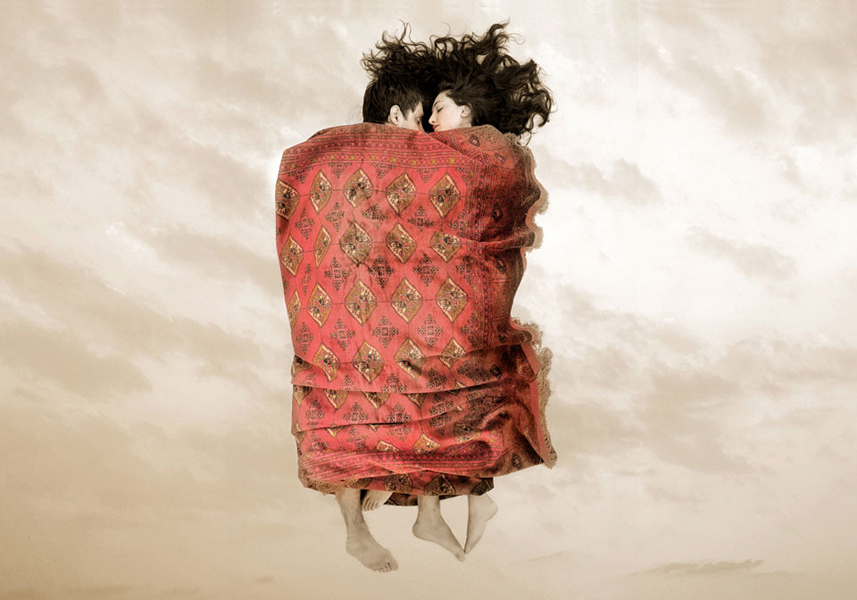
Parvaneh Etemadi, born in Tehran in 1948, with nearly five decades of lively presence on the scene of visual arts, Parvaneh Etemadi is one of the most successful and popular Iranian artists both in the eyes of art virtuosos and laymen.
Even though she was born in Tehran, Etemadi she spent her early childhood in the city of Birjand (in south of Khorasan close to the vast barren eastern Iranian plateau). After finishing both her primary and secondary education in Tehran she began to study at the Fine Art College of Tehran University (1967). This coincided with the foundation of Ta’la’r-e Iran (Hall of Iran, later changed to Talar Ghandriz) by a group of visual arts activists; a significant event attracting many young artists including Parvaneh who not only participated in more than 10 group exhibitions displayed there from 1967 to 1977, but also held her first solo exhibition at the same hall (Ghandriz) in 1969.
During the first period of her artistic activity she appeared as an abstract painter. Her abstract works were free compositions of forms appearing in pleasing proportions with extensive touches of cold opaque colors, nevertheless designed and worked out candidly and resolutely.
This second period of her artistic activity which took shape in the seventies was a synthesis of constructivism of her first period with a return to figurative art. The works of this period with their rough sketchy textures of oil color on a cement infrastructure and their modern minimal structure, together with the least application of line and color as well as design and figure emerged as plain agreeable charming still lives
In the third period of her works (from 1980 onwards) was a return to the imaginary basement of her grandmother with trunks of old forgotten outfits and textiles. During this period, by virtue of her perfect brilliant technique, a colorful pallet of warm shinny harmonious and balanced colors, she reproduced fine garments and textiles of silk and termeh designed with familiar flowers, fruit and home utensils in very gorgeous still lives.
In her collages which mark the fourth period of her work, Etemadi began a new venture. Her compositions now made up of cut photocopied pieces of her previous color pencil paintings glued on the surface of wide canvases with still more colorful and varied pallet appeard as a kind of artistic improvisation of fantastic free dancing outfits often breaking through the surface and the frame of the canvas as though refusing to be imprisoned in any limited fixed form.
After 2000, Parvaneh Etemadi ventured new experiences. Participation in an installation calling public attention to the environment in Hanover, Germany in the same year, working with ceramic and combining it with calligraphy displayed in an applied art exhibition held at House of Iranian Artists and finally beginning a new period (still continuing) exhibited under the title Once upon a Time held at Golestan Gallery in 2004 showing the peak of her collages, this time combined with ancient Iranian myths, fables and literature. More on Parvaneh Etemadi
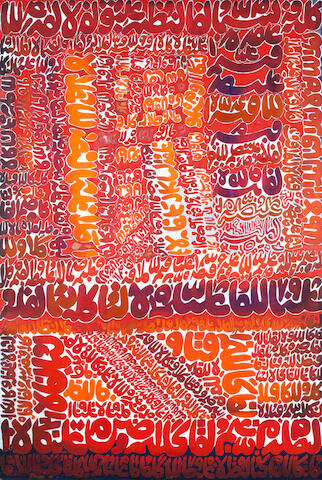
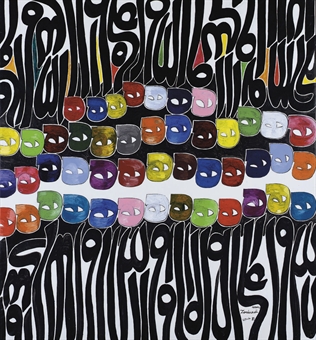
Charles Hossein Zenderoudi (born 1937 Tehran) is one of Iran's most accomplished modern artists, and as a founding father of the highly influential Saqqa Khaneh movement, has been a pioneering figurehead of Iranian neo-traditionalism.
His choice of subject matter, calligraphy, has historically been the most established mode of formal artistic expression prevalent in Iran, but, by emphasizing form over meaning, and by stripping the written word down to its aesthetic, structural, fundaments, Zenderoudi subverts the traditional values of Persian calligraphy. Zenderoudi's text is intentionally illegible and carries no literal meaning, freeing it from the constraint of linguistic limitation, and imbuing it with a sense of universality which rescues the archaic practice of calligraphy from obscurity, giving it renewed relevance in a contemporary context.
Zenderoudi's compositions pay homage to centuries of Persian religious imagery and employ a systematic repetition of letter-forms that finds its genesis in the mystical practice of Sufi numerologists, who believed in the spiritual significance of singular letters and worked these principles into hugely intricate talismanic charts. Zenderoudi's methodical compositions, whilst not accurately following the grammar or axioms of numerology, capture the aesthetic and conceptual qualities of its cryptic nature.
Zenderoudi's early works focused on dense talismanic imagery, mixing iconography, freehand script and numerals. The density of these compositions sought to capture the visual intensity of popular religious expression in Iran, where banners, standards, altars, murals and mosques exuberantly adorn the urban landscape.
Works from the present series, composed in the early 1970's, mark a shift towards a more compositionally terse, technical and measured approach to calligraphy. The crowded iconography of the early works is replaced by a greater focus on larger letter-forms, which exhibit a formal refinement lacking in their earlier counterparts.
Measured but spontaneous, technical yet effuse, Zenderoudi' manipulates Persian calligraphy with effortless ease, boasting a visual scope which faithfully captures the salient elements of Iran's traditional popular religious aesthetic. Rendered with the use of rich and vibrant colours, his canvases replicate the tonal and textural qualities of the votive art so common to the Iranian urban landscape. More on Charles Hossein Zenderoudi
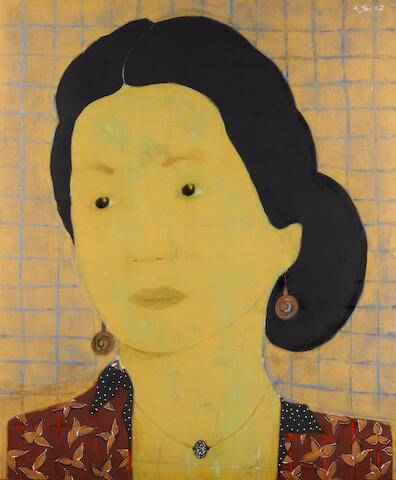
Adel El Siwi ( Behera , 1952) is an artist Egyptian. Adel was born in 1952 in Behera , in Egypt . He studied at the Faculty of Medicine of Cairo in 1976. Meanwhile, independently attended the Faculty of Fine Arts in Cairo. Since 1979 painting becomes a full-time business. In 1980 he moved to Milan , where he lived for the next ten years. In 1990 he returned to Cairo, where he still lives. After the debut exhibition in a gallery in Cairo, he showed his works around the world, from Egypt to Germany from Lebanon to Italy, until arriving in Mexico and Brazil. Parallel to the artistic success, his work dealt with other issues, such as the translation into Arabic of the Treatise on Painting by Leonardo da Vinci. In addition, he worked as art director for the big screen and has signed publications on contemporary art. More on Adel El-Siwi
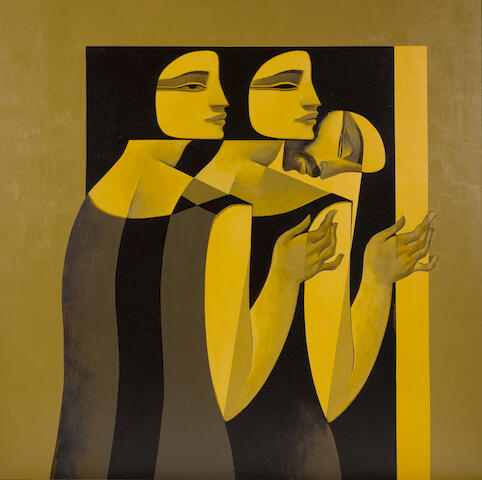
Safwan Dahoul completed his first Dream in 1987, he has painted the same woman in the same muted monochromatic colours on what he assumes has been more than 1,000 canvases (although he never kept count). Every time, he titled it Dream. More on Dream
Safwan was born in Hama, Syria in 1961. He graduated from the Fine Arts Faculty of Damascus in 1985 and continued his experimentation and education till 1997 when he was awarded a Doctorate in Plastic Arts from the Higher Plastic Arts Institute of Mons, Belgium. During his career, Safwan has exhibited and sold out most of his solo shows throughout the Middle East and Europe. More on Safwan Dahoul
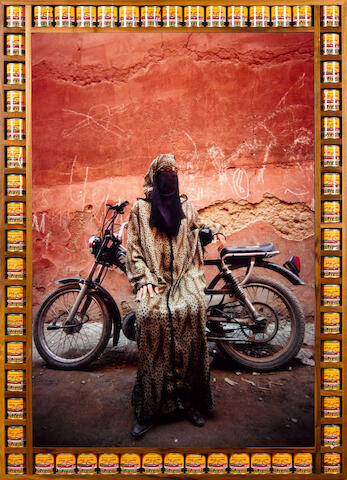
Hassan Hajjaj (b. Larache, Morocco in 1961) is a contemporary artist who lives and works between London, UK and Marrakech, Morocco, and is known as the “Andy Warhol of Marrakech.”
Hajjaj's work is in the collections of the Brooklyn Museum, New York; the British Museum, London; the Nasher Museum of Art, Duke University, Durham, NC; the Newark Museum, New Jersey; Los Angeles Museum of Contemporary Art, Los Angeles; the Victoria & Albert Museum, London; the Farjam Collection, Dubai; Institut des Cultures d’Islam, Paris; Kamel Lazaar Foundation, Tunisia; and Virginia Museum of Fine Art, Richmond, VA.
Hajjaj was the winner of the 2011 Sovereign Middle East and African Art Prize and was shortlisted for Victoria and Albert Museum's Jameel Prize in 2009. In 2013, Rose Issa Projects published a monograph of the artist exploring his upbringing in Morocco and London, his experiences in fashion and interior design, and his adventures in the music industry influence the vibrant colours, joyful spirit, and visual rhythm of his highly sought-after images.
Hajjaj's first feature-length film, Karima: A Day in the Life of a Henna Girl, premiered at the Los Angeles County Museum of Art in May 2015. The film takes viewers into the world of one Hajjaj’s most iconic series, Kesh Angels, depicting the henna girls of Marrakesh. The film will be subsequently shown at Art Basel in Basel, Switzerland in June 2015, curated by Cairo-based film curator and lecturer Maxa Zoller. More on Hassan Hajjaj
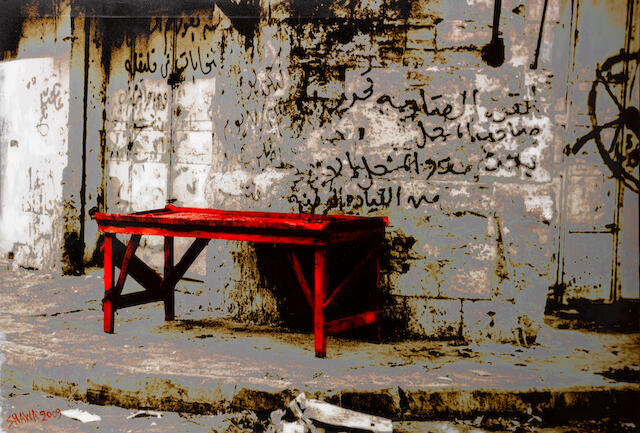
Laila Shawa (Born Gaza 1940) is a Palestinian artist. Her work has been described as reflecting a view of the politics of her country highlighting perceived injustices and persecution. Often her work uses photographs that are used as the base for silkscreen printing. Her work has been internationally exhibited and has work on display in many public (e.g. The British Museum) and private collections.
In 2012 to go alongside the AKA Peace Exhibition at the ICA Art Below showcased selected works from the AKA Peace series on the London Underground including Shawa's. "AKA Peace" originally conceived by photographer Bran Symondson and now curated by artist Jake Chapman, is an exhibition of new works made specially for The Peace One Day Project 2012, bringing together a group of Contemporary Artists, all of whom agreed to transform a decommissioned AK-47 assault rifle, refashioning into artworks. More on Laila Shawa
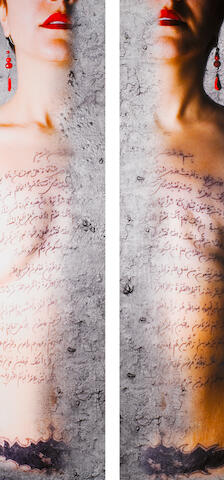
Private collection
Mania Akbari (born 1974) is an internationally acclaimed Iranian filmmaker, actress, artist and writer whose works mostly deal with themes of sexual identity, women, marriage, abortion, infidelity and lesbianism. Her style, unlike the long tradition of melodrama in Iranian cinema, is rooted in modern visual arts and the avant-garde. Akbari, because of the themes discussed in her films and her opposition to censorship, is considered as one of the most controversial filmmakers in Iran. As an actress, she is probably best known for her role on Abbas Kiarostami's Ten. More on Mania Akbari
Please visit my other blogs: Art Collector, Mythology, Marine Art, Portrait of a Lady, The Orientalist, Art of the Nude and The Canals of Venice, Middle East Artists, 365 Saints, 365 Days, and Biblical Icons, also visit my Boards on Pinterest
Images are copyright of their respective owners, assignees or others.
Some Images may be subject to copyright
I don't own any of these images - credit is always given when due unless
it is unknown to me. if I post your images without your permission, please tell
me.
I do not sell art, art prints, framed posters or reproductions. Ads are
shown only to compensate the hosting expenses.
If you enjoyed this post, please share with friends and family.
Thank you for visiting my blog and also for liking its posts and pages.
Please note that the content of this post primarily consists of articles
available from Wikipedia or other free sources online.




No comments:
Post a Comment